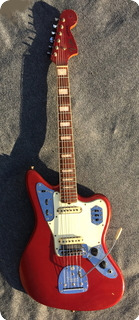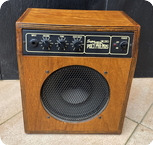Fender / Jaguar / 1966 / Candy Apple Red / Guitar
1966 JAGUAR, Candy Apple Red, pearl block inl, RW code FE006
Original Candy Apple Red Finish custom color w/ matching head-stock in Very Good Overall Condition With Small Dings. Alder Body. Neck binding and block inlays. Frets in good conditions Truss Rod Functions Properly. All Original Parts Original Pickups Sound & Plays Great With A Low Action. Kluson tuners. The two "grey-bottom" single-coil pickups have well-balanced outputs. Original Hard Shell Case Is Included
https://www.youtube.com/watch?v=zekcMwd-ocw
1962 Jaguar
The Jaguar was launched in 1962 as another top-of-the-line guitar in the same vein as the Jazzmaster. Both guitars shared the modern offset body shape and distinct floating tremolo system.
The Jaguar differed in its use of a shorter 24-inch scale length and stronger single-coil pickups,which were encased in notched covers to shield the electronics from external radio noise
(a typical annoyance with the Jazzmaster's soapbars).Both guitars integrated a unique dual rhythm/lead circuit design, yet on the Jaguar the lead circuit includes three switches:
on-off for the front pickup, on-off for the back pickup, and a bass-cut switch that adds an extra capacitor to the signal. As a high-end member of the Fender line-up, the Jaguar sported deluxe upgrades such as chrome coverings on the hardware and a newfangled string-mute system, which never really caught on with players.
1964 Jaguar
The end of 1964 brought the handover of Fender management to the CBS corporation and the beginning of what's known as the transition era for the company. Changes seen on the Jaguar in this period include a switch from clay to pearloid fingerboard inlays in 1965, as well as the use of a three-layered plastic pickguard and Kluson F-style tuners which were both fully integrated by the end of 1966.A note on finishes: Like all Fenders from the '60s, custom and rare finish options increase the value of a vintage Jaguar substantially. Sunburst was standard. Any other original finish is considered more sought-after. Fender's palette of colors used in the '60s closely aligned with those used on General Motors cars, with most of the paint coming from the same place. For the Jaguar, a guitar targeted towards surf guitar players, this connection is all the more obvious. Think, for example, of classic images of the Beach Boys cruising through Southern California with Jaguars in hand.
1966 Jaguar
Perhaps the most striking change brought to the Jaguar (as well as the Jazzmaster) through the transition era of 1964 to 1966 was on the neck. The Jaguar neck evolved from using an unbound fingerboard with dot inlays for its first several years to a bound neck with dot inlays in mid-1965, and eventually to a bound neck with trapezoid inlays by the end of 1966. While typically collectors think earlier the better when it comes to this era of Fender guitars, lots of players do have a certain affinity for the trapezoid-binding combo.
1969 Jaguar
With the renewed popularity of the Stratocaster (thanks to Mr. Hendrix), Fender emphasized the top-of-the-line status of the Jazzmaster and Jaguar less and less by the end of the '60s. While the design of the Jaguar stayed largely the same through this era, the switch from nitrocellulose to polyester finishes on most Fenders in 1968 reflects the continuing decline in quality seen throughout the CBS era. This is part of what renders these instruments of less value to collectors than the early models.
1973 Jaguar
The Jaguar was discontinued entirely in early 1975 and production numbers remained low through the last several years. Like the Jazzmaster, which failed to gain ground with jazz players, the Jaguar was not the commercial smash Fender hoped it would be. For years, the Jaguar remained an almost forgotten stepchild in the Fender family, which allowed players to grab them on the cheap. In the '80s and '90s, more and more alternative and indie rock guitarists looked to the offbeat appeal of the Jazzmaster and Jaguar. Included in their ranks was a young man from Washington named Kurt Cobain.
Hendrix Guitars, Italy 
Welcome to HENDRIX VINTAGE
Hendrix Vintage is the first Vintage Collector in Italy with the best Vintage instruments Guitars Bass Amplifiers Effects carefully inspected to guarantee originality and high quality since 1978. All info in site: www.hendrixguitars.com
and also see: http://www.hendrixguitars.com/HendrixVintage.htm
All shipping handled by GLS or Poste Italiane (Europe) or EMS (World) for fast and reliable delivery with tracking. Options: UPS (more expansive) The payment is through money bank transfer (or MoneyGram or Wester Union or Transferwise very easy directly from your credit card or your bank account see the web) Sorry no credit card or Paypal direct. Particular care and attention to create an anti-breakage packaging.


























